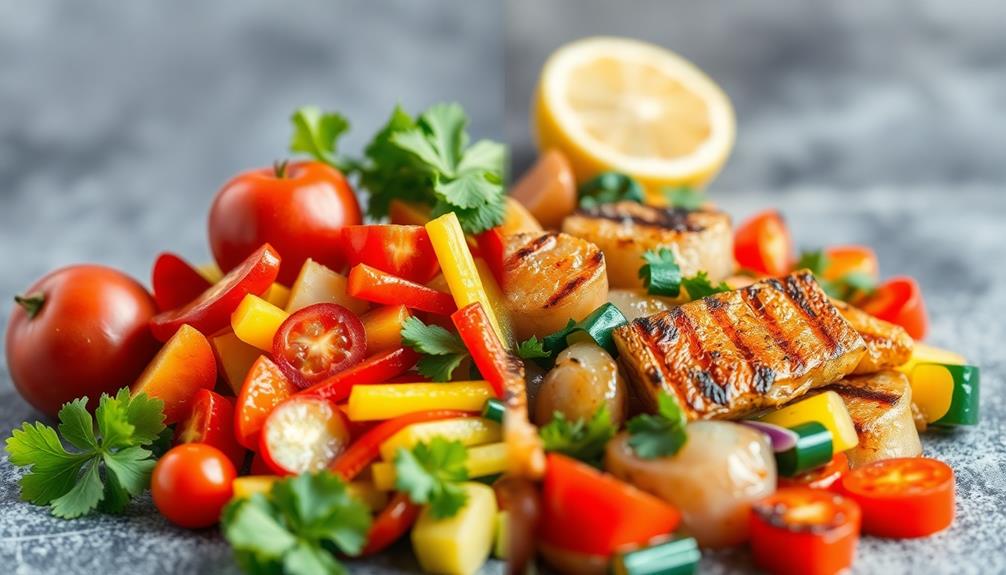Different cooking methods can greatly affect food's DNA. High-temperature techniques like grilling and frying cause increased DNA damage, especially in meats, by leading to harmful nucleoside production. For instance, cooked beef shows a tenfold increase in uracil levels compared to raw. Meanwhile, gentler methods like steaming can preserve DNA integrity. Chronic consumption of foods prepared with high heat may raise cancer risks due to these changes. Understanding how these methods impact DNA can help you make more informed cooking choices. Learn more about cooking techniques that could mitigate these risks and promote healthier eating habits.
Key Takeaways
- High-temperature cooking methods like grilling and frying significantly increase DNA damage in foods, particularly in meats.
- Cooking meat at high temperatures raises uracil levels tenfold and 8-oxo-2'-deoxyguanosine levels 3.5 times.
- Longer cooking times and temperatures above 200 °C lead to greater DNA degradation in foods.
- Gentler cooking methods, such as steaming and stewing, help preserve DNA integrity and reduce health risks.
- Chronic consumption of heat-damaged DNA foods may heighten cancer susceptibility due to increased mutagenic risks.
Health Risks of Cooking Methods
When it comes to cooking methods, the health risks can be surprising. You mightn't realize that cooking at high temperatures, like grilling or frying, can greatly increase DNA damage in your food.
For example, traditional Brazilian dishes often incorporate grilling techniques that enhance flavors but may also lead to increased health risks. Studies show that roasting meats can lead to a tenfold increase in uracil levels compared to uncooked versions. This kind of heat-induced DNA damage is linked to a higher risk of cancers, particularly colorectal cancer associated with red meat consumption.
The cooking methods you choose can create mutagenic lesions, such as 8-oxo-2'-deoxyguanosine, which may contribute to genomic instability when ingested. The FDA even recommends cutting back on deep-fried foods and red meat due to their ties to metabolic syndromes like type 2 diabetes and cardiovascular diseases.
Additionally, dishes like Caldeirada, which are often prepared using stewing techniques, may present a healthier alternative.
On the flip side, boiling is a method that may cause less DNA damage in comparison to roasting or frying. This highlights the importance of cooking techniques on food safety and overall health outcomes.
Mechanisms of DNA Damage
Cooking at high temperatures can lead to considerable chemical changes in food DNA, primarily through hydrolytic and oxidative damage. For instance, traditional Chinese dishes that require slow braising, like Red-Braised Pork Belly, are cooked for extended periods, which can exacerbate DNA degradation.
When you cook foods, especially meats, you can create mutagenic lesions, including uracil and 8-oxo-2'-deoxyguanosine. Studies show that cooking meat increases uracil levels tenfold and 8-oxo-dG levels 3.5 times compared to raw foods. This heat-induced deamination of nucleotides happens at elevated temperatures, which can result in genomic instability and even carcinogenic effects.
The damaged nucleotides found in cooked foods can sometimes be salvaged by your cells and incorporated into genomic DNA. This process can trigger DNA repair mechanisms, but it also raises the risk of chromosomal damage.
You mightn't realize that the degree of DNA degradation varies considerably based on meat type and the cooking method used. Longer cooking times typically lead to a greater loss of detectable DNA integrity. By understanding these mechanisms of DNA damage, you can make more informed choices about cooking methods and the potential risks associated with consuming heavily cooked foods.
Types of Heat-Induced Damage
Heat-induced damage in food DNA manifests in several ways, primarily through the formation of harmful lesions that disrupt genetic integrity. Different cooking methods and temperatures play a significant role in how much damage occurs. For instance, roasting and boiling elevate uracil levels and oxidative damage substantially.
Certain Indian dishes, like Mushroom Masala, may retain more nutrients when cooked at lower temperatures compared to others that require higher heat for flavor enhancement.
Some key types of heat-induced damage include:
- Increased uracil levels: Studies show a tenfold rise in uracil in roasted meats compared to raw samples.
- Oxidative damage: Cooking can produce 8-oxo-2'-deoxyguanosine, indicating a 3.5-fold increase in oxidative DNA damage.
- Mutagenic lesions: Elevated cooking temperatures accelerate nucleotide deamination, leading to genomic instability and impaired genetic function.
As you cook food at higher temperatures for longer periods, expect more pronounced DNA degradation.
The degree of damage varies by species, impacting species identification accuracy when using PCR techniques. Heat-induced damage can result in serious consequences for the integrity of food DNA, making it essential to reflect on the methods you use while cooking.
Quantifying DNA Damage in Foods
Quantifying DNA damage in foods provides essential insights into the effects of various cooking methods on genetic integrity. High-temperature cooking methods, like roasting and boiling, lead to considerable increases in DNA damage, especially in meats.
For instance, when preparing dishes like Chilaquiles with roasted ingredients, the risks of DNA degradation can be pronounced. Studies show that uracil levels can spike tenfold in roasted meats compared to their raw counterparts. When you cook at temperatures above 200 °C for extended periods, the degradation of detectable DNA becomes substantial, correlating longer cooking times with greater DNA loss.
Heat-induced DNA damage results in mutagenic lesions, such as the conversion of cytosine to uracil and oxidation of guanine, which can impair gene function and contribute to genomic instability. Research indicates that when you consume cooked foods, damaged nucleotides can be absorbed during digestion, raising potential health risks associated with dietary intake.
Interestingly, the quantification of DNA damage varies by food type, with meats exhibiting considerably higher levels than plant foods. This suggests that you should scrutinize cooking practices not only for their culinary benefits but also for their impact on food safety and your overall health.
Cellular Responses to Damaged DNA
Exposed to damaged nucleosides from cooked foods, cultured cells activate robust DNA repair mechanisms to counteract potential harm. When you consume these foods, your cells respond to DNA damage through various cellular responses, including base excision repair (BER).
This is particularly important when considering various cuisines, such as traditional Angolan dishes like Muamba De Galinha, which often involve high-heat cooking methods that can affect food composition. You might be surprised to learn about the implications of heat-induced damage in your meals.
Here are a few key points:
- Increased DNA Repair Activity: Elevated BER activity indicates that your cells work hard to incorporate damaged nucleotides into their DNA.
- Genomic Instability Risks: The incorporation of deaminated nucleotides can potentially lead to double-strand breaks, particularly in the intestines.
- Research Needs: There's an ongoing need for more research on dietary guidelines and cooking practices to mitigate these risks.
Dietary DNA Content and Risks
When you cook foods, especially at high temperatures, you greatly alter their DNA content.
For instance, methods like slow-cooking or roasting can enhance flavors while potentially reducing harmful components through careful preparation, such as in dishes like slow-cooked pork belly.
This not only increases the levels of harmful DNA lesions but also raises concerns about the long-term health risks associated with consuming these damaged nucleotides.
Understanding how different cooking methods impact dietary DNA can help you make informed choices for your meals.
DNA Levels in Foods
Understanding the DNA levels in foods is essential, especially when reflecting on how cooking methods can affect dietary DNA content and potential health risks. Different foods contain varying amounts of DNA, with animal products generally having higher levels than plants. For instance, beef liver contains up to 19.5 g/kg of dry matter DNA, while broccoli has only 5.1 g/kg.
Curiously, traditional Italian dishes like Agnolotti highlight how the preparation of ingredients can influence both flavor and nutritional content, including DNA levels.
When you cook foods, especially meats, high temperatures can lead to significant DNA damage. This degradation often results in increased levels of damaged nucleotides like uracil and 8-oxo-2'-deoxyguanosine.
Here are some key points to reflect on:
- Cooked meats show higher DNA lesions compared to their raw counterparts.
- Average meals may include up to 1 gram of DNA from various sources, raising concerns about incorporating damaged DNA into your cellular DNA.
- Ongoing research highlights a potential link between heat-damaged DNA consumption and long-term health risks.
Understanding these dietary impacts can help you make informed choices about your cooking methods and food selections, ultimately safeguarding your health.
Cooking Methods' Impact
Cooking methods can drastically alter the DNA content in your food, especially when it comes to meats. High temperatures, like those used in roasting and boiling, considerably increase DNA damage. For instance, studies show that cooked beef exhibits a tenfold increase in uracil levels compared to raw samples. This degradation affects DNA quantification, with longer cooking times leading to a greater loss of detectable DNA in meat products.
Additionally, some traditional dishes like Dorayaki (Red Bean Pancake) preserve their integrity due to gentler cooking methods, highlighting the significance of technique in culinary practices.
When you cook at temperatures around 200 °C for extended periods, the risk of substantial DNA damage rises, which can hinder species identification through real-time PCR. The consumption of heat-damaged DNA from high DNA content foods, such as beef and pork, raises concerns about potential genetic mutations and associated health risks.
Additionally, this DNA damage isn't exclusive to meats; cooked vegetables can also contain compromised nucleotides. Consequently, it's vital to adopt cautious cooking practices to minimize the risks of incorporating these damaged components into your cellular DNA.
Long-term Health Risks
Eating foods cooked at high temperatures can pose significant long-term health risks due to the DNA damage they contain. When you roast or grill meats, you increase harmful DNA lesions, like uracil and 8-oxo-dG, by several times compared to raw foods. This damage can lead to the incorporation of heat-damaged DNA into your cells, raising your cancer susceptibility.
For instance, classic Southern dishes such as squash casserole can be prepared in a way that minimizes these risks by opting for baking instead of frying.
Consider these key points:
- Cooking methods like frying and grilling elevate chronic health risks.
- High DNA content foods, particularly red and processed meats, are especially concerning.
- Repair mechanisms in your body may struggle to counteract the effects of DNA damage from these cooked foods.
The FDA has cautioned against frequent consumption of high-temperature cooked foods, linking them to increased risks of colorectal and pancreatic cancers.
While your body has some capacity to repair DNA damage, the long-term effects of consuming heat-damaged DNA remain unclear. Future studies are essential to understanding how these risks manifest over time and how effectively your body can handle the DNA lesions generated during food digestion.
Long-Term Effects of Cooked Foods
When you cook your food, especially at high temperatures, you might be exposing yourself to heat-damaged DNA that could have lasting effects on your health.
For instance, traditional Indonesian dishes like Kue Putu highlight the benefits of steaming over frying, as steaming preserves nutrients and minimizes harmful compounds.
The risks of genetic mutations and diseases, like cancer, can increase over time due to the accumulation of damaged nucleotides in your body.
Understanding how different cooking methods contribute to this issue is essential for making healthier dietary choices.
Genetic Risks Overview
Heat can remarkably alter the DNA structure in the foods you consume, leading to potential long-term health risks. Cooking methods that involve high temperatures, like grilling and frying, can greatly increase DNA damage in the food.
Studies show that roasting meat may elevate levels of damaging nucleosides, with cytosine converting to uracil and guanine undergoing oxidation. This alteration can contribute to genomic instability when ingested.
Consider these key points:
- Processed meats and red meat often contain higher levels of heat-damaged DNA, increasing mutagenic risks.
- Chronic consumption of foods with damaged DNA may heighten your cancer susceptibility.
- The average meal can contain over 1 gram of DNA, raising concerns about cumulative effects.
As you enjoy your meals, keep in mind that these long-term health risks are tied to the DNA damage caused by your cooking methods.
Further research is essential to fully understand the implications of consuming heat-damaged DNA over time. By being aware of these factors, you can make more informed choices about how you prepare and consume your food.
Dietary DNA Damage
Many people mightn't realize that the cooking methods they choose can markedly impact the DNA integrity of their food. Cooking at high temperatures can lead to significant DNA damage in cooked foods. Studies reveal that roasting meat, for instance, can increase DNA damage by up to tenfold compared to raw options. This damage often manifests as harmful lesions like uracil and 8-oxo-2'-deoxyguanosine, both of which are linked to potential health risks.
When you consume heat-damaged DNA, your body can incorporate these damaged nucleotides into your own DNA, raising concerns about genetic mutations and long-term health implications.
In fact, the average meal may contain over 1 gram of DNA from cooked vegetables or meats, suggesting that dietary intake of damaged DNA could have cumulative effects on your health. Ongoing research aims to uncover the long-term effects of consuming low doses of heat-damaged DNA, particularly regarding chronic diseases like cancer and metabolic disorders.
Cooking Methods Comparison
Cooking methods can profoundly influence the long-term effects of the foods we consume, particularly regarding their DNA integrity. High-temperature cooking techniques, such as grilling or frying, can considerably raise uracil levels in cooked meats, leading to potential DNA degradation.
Research shows that cooking at temperatures around 200 °C for extended periods can cause substantial damage to DNA, with longer cooking times correlating to greater losses in detectable DNA copy numbers.
Consider these key points about how different cooking methods affect DNA integrity:
- High-temperature cooking often results in oxidative modifications, impairing gene function.
- Meat tends to exhibit more severe DNA degradation compared to plant tissues.
- Frequent consumption of heat-damaged DNA may increase cancer risks over time.
While plant foods like potatoes show less DNA degradation, the protective benefits of consuming them shouldn't be overlooked.
It's vital to be mindful of the cooking methods you choose, as they can pose health risks through damaged DNA, impacting long-term well-being. Future studies will be important to fully understand the implications of consuming foods cooked at high temperatures.
Future Research Directions
As researchers explore deeper into the intricate relationship between cooking methods and food's DNA, future studies will expand to include a wider variety of techniques, such as microwaving and sous-vide.
By examining these methods, you'll gain insights into how they affect DNA integrity across different food types.
One critical area of focus will be the long-term health implications of consuming heat-damaged DNA, especially concerning specific cancers like colorectal and small intestine cancer.
Future research will evaluate the differences in DNA damage between high DNA content foods, such as meats, and low DNA content foods, like vegetables, helping you understand the dietary risks associated with various cooking styles.
Moreover, investigating the efficiency of DNA repair mechanisms in response to heat-damaged nucleotides will be essential for understanding how these changes impact human health.
Collaborative studies involving interdisciplinary teams will be crucial in developing standardized cooking protocols that minimize DNA damage while ensuring food safety and palatability.
As these avenues are explored, you'll be better equipped to make informed decisions about your cooking methods and their potential effects on health.
Implications for Food Safety
The exploration of how cooking methods impact food DNA brings significant implications for food safety. Cooking at high temperatures can lead to DNA damage in food, creating harmful nucleosides that may enter your bloodstream when consumed. This has serious health risks, particularly related to genomic instability in your intestines, which could increase your likelihood of developing cancer.
Consider these points:
- High-temperature cooking methods, like grilling and frying, can elevate DNA lesions in red meats.
- Studies show that cooking at temperatures above 200 °C for extended periods dramatically increases specific DNA damage.
- The FDA advises limiting the intake of cooked red meats and deep-fried foods due to their link to increased cancer risks.
As researchers work toward establishing standardized cooking protocols, it's vital to understand how different cooking methods affect food safety.
Frequently Asked Questions
How Do Different Cooking Methods Affect Food?
Different cooking methods affect food by altering its texture, flavor, and nutritional content. You'll notice that high-heat techniques like frying can create crispy exteriors, while steaming retains moisture and nutrients, enhancing overall taste and health benefits.
How Does Food Affect Your DNA?
Did you know beef liver can contain up to 19.5 g/kg of DNA? When you eat food, its DNA can interact with your cellular DNA, potentially affecting your genetics and long-term health in surprising ways.
How Does Heat Affect DNA?
Heat causes DNA damage by increasing levels of lesions, like uracil, in food. When you consume these foods, your body may incorporate damaged components, potentially leading to genetic mutations and health risks over time.
How Different Cooking Methods Affects the Quality of Meat?
If you think boiling your steak is gourmet, you're in for a shock! Different cooking methods can turn juicy meat into a chewy disaster, so choose wisely to keep your dinner delicious and tender.
Conclusion
To sum up, understanding how different cooking methods affect food's DNA can help you make healthier choices in the kitchen. Did you know that studies suggest cooking at high temperatures can double the DNA damage compared to gentler methods? By opting for steaming or slow cooking, you can minimize these risks and preserve more nutrients in your meals. So, next time you cook, consider how your method might impact both your food and your health!








